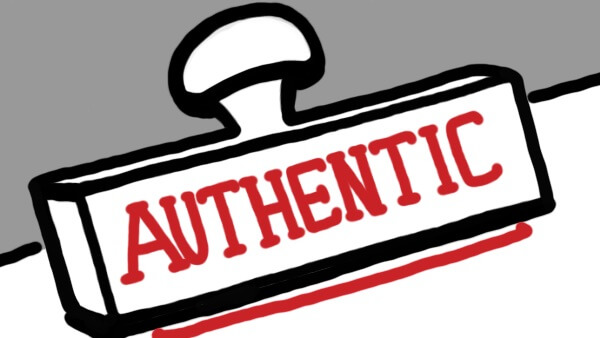Authenticity, Relevance, and Quality
“We’re not really sure what makes some marketers think they don’t need [images]. Maybe they don’t think images are professional”. It’s at this point that Jacinda Santora drops an image into her blog post—a plus-sized picture of a digital figure holding up its hands in confusion. “That couldn’t be further from the truth,” she concludes.
Research has shown that visual storytelling, overall, is a powerhouse tool that can increase not only engagement, but retention of messaging. Here, we’ll be looking more closely at (to stretch Santora’s words) the professionalism of the image. Put more simply, it’s the successful usefulness of visual storytelling in marketing.
What Makes Visuals Successful?
First, let’s establish what makes visuals successful in marketing. It’s not the mere presence of imagery that ensures that a message will connect and stick. At TruScribe, we thrive on our artists’ ability to produce just the right images to reinforce the client’s voiced message.
In any marketing effort, you’ll want to be equally selective of the visuals in your visual story. Mydee Lasquite recommends that you start by examining your visuals with an eye for authenticity and genuineness. Don’t join what Lasquite refers to as the “wonderful world of deception” that many view marketing to be. Show them, instead, “real-life depictions.”
An Example of Successful Visuals
For example, do what doll company Lammily did.
They released dolls with more realistic proportions than those Barbie promoted. Their dolls provided a realistic alternative to real problems (bullying and self-consciousness). Girls and parents could identify with the reality Lammily was promoting, and the great and powerful Barbie suddenly had a potential threat. This, Lasquite argues, is the strength of authentic visuals.
Lammily was successfully addressing more than its competitor’s weakness: it was presenting visuals that were culturally relevant. Bullying and body-shaming were a part of life, so Lammily confronted the issues head-on. Since it was already in the cultural zeitgeist, they understood that people would engage with their message.
The public only needed to see Lammily communications whose visuals showed that they were in step with that zeitgeist. And once they saw Barbie’s visuals—unchanged, uninterested in changing, uninterested in addressing social issues—Lammily looked even more appealing.
High-Quality Visuals are Important
Beyond being authentic and culturally in-touch, remember that there’s a broader concern that applies to all visuals: quality matters. This means fighting the urge to be faster and more immediately available than your competitors. This is sometimes a hard urge to overcome but always ensures that your visuals are as well-created as possible.
It also means avoiding one of the worst things your visual storytelling can include: poorly rendered imagery. While successful visual storytelling underscores your message and makes it memorable, visual storytelling that’s plagued by poorly designed or rendered imagery tends to do the opposite. Take the time to create and distribute only the best visuals that you can.
In the same vein, make your images meaningful. This goes beyond authenticity and cultural relevance to more basic questions:
“Is this visual communicative in itself?” and
“Is it compelling enough to excite the users to read/learn more?”
Get to the Point – And Make it Matter
Whether you’re convinced of the tiny and still-diminishing attention span of the modern world, or you still believe viewers are able to stick with your message for more than a few seconds, the fact remains: you don’t have forever with your viewers.
So don’t waste any time with boring or empty visuals. As above, avoid the urge to hurry, and create visuals that speak for themselves—even as their collective effect is to amplify your message.
Continuing on best practices for visual storytelling in marketing, Kristin Twiford recommends that your department “Build a consistent visual identity across platforms”. In other words, be explicit about the kinds of visuals consumers can expect in your visual stories, and provide examples.
This will ensure that “everyone is on the same page,” and increase your return traffic and interest in the brand. To use a cinematic analogy, it’s often easier to sell a sequel than a wholly new screenplay. The reason? Familiarity breeds closeness and repeat visits, while novelty is more successful at getting attention. Build a consistent visual identity for the familiarity that becomes retention.
Encourage Your Customers to Share
Speaking of genuine familiarity, Twiford’s suggests that you source user-generated content for your visual marketing story. When your customers engage with your products through social media or other methods, you’ve gotten a powerful gift.
It’s one thing to be authentic in the kinds of characters you design for your visual story, but it’s quite another to actually populate your visual story with actual users. While your audience will know that there is a level of curation in your visual story (they won’t be ‘fooled’ in some overwhelming sense), seeing real users of your products or services will speak loudly and attractively.
So, what does the ideal visual story for marketing look like?
Experts seem to agree that it looks like a well-produced, quality group of images that feels authentic, meaningful, relevant, consistent across your company’s platforms, and, if possible, includes actual customers.
Will every one of these elements be easy to include in all of your visual storytelling for marketing? Perhaps not, but the situation is not all or nothing. If you produce a visual story for marketing that is high-quality with appropriate cultural relevance and fits your visual identity, you’ve probably got a strong piece of messaging.
Successful visual storytelling for marketing isn’t an equation, as much as it’s a discussion of what people connect with. Here, we have identified some of the best ways to market with visual storytelling. They provide a great place to get started—and remember (to close with one more piece of Jacinda Santora’s advice): “The last technique is to test.” Start practicing visual storytelling for marketing today.

